For the first time, this year’s report presents data that reveals the number of Israelis working as salaried employees in technology positions in Israel, both in the high-tech sector and in other sectors. The data relates to salaried employees in the high-tech sector, both in technology and non-technology jobs, and in technology jobs in other sectors. In other words, in addition to the accepted definition of salaried employees in different roles in the high-tech sector that is published every year, this report also includes further data pertaining to those employed in roles of a technological nature in other sectors of the economy e.g., a programmer in a bank or a retail chain.
This broader definition of jobs, that includes salaried employees in technology roles across the economy as well as all those employed in the high-tech sector is called “tech jobs”. The change in the data published stems from implementation of the recommendations issued by the National High-Tech Human Capital Committee (the Perlmutter Committee) that emphasized the importance of technology employees throughout the economy, including those outside the high-tech sector, as an engine for increasing productivity and the standard of living in Israel. See the report of the National High-Tech Human Capital Committee (in Hebrew): nov2022.pdf (www.gov.il)
According to the new and expanded definition, The data presented here differs slightly compared to the definition adopted by the Perlmutter Committee and relates to salaried employees of all ages, and not just to employees aged 25-64. there were 508,400 salaried employees in high-tech and technology roles in 2022 – comprising 14% of all salaried employees in Israel. In 2014, this figure stood at 10.6% (a total of 328,300 employees) i.e., the relative share of salaried employees in tech jobs recorded a significant increase of 32%. These figures highlight the importance of high-tech jobs in their broader definition to the economy, as they increasingly attract more and more employees.
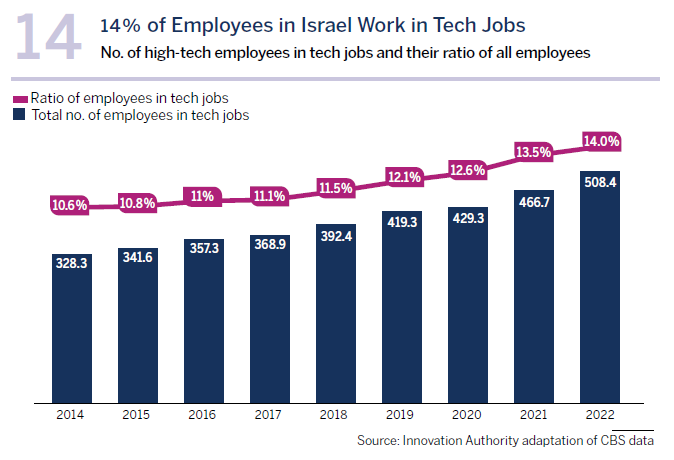
Recent years have seen the emergence of complete companies – startups established in Israel that continued growing and expanding here – on a greater scale than seen previously. The common perception is that these companies also employ workers in roles other than core technology roles for example, in marketing, sales, human resources and others. Furthermore, according to this perception, these companies are a more significant cornerstone of employment in Israel than the multinational companies’ development centers where the main emphasis is on the development departments and on employment in technology jobs.
An analysis conducted by the Innovation Authority reveals that complete software companies employ an average of 2.55 employees in non-technology jobs for each employee in a technology job such as engineering or development. This ratio of non-technology employees per technology employees is called an “employment multiplier” and of all the types of high-tech companies operating in Israel, the “employment multiplier” is highest among complete software companies. In contrast, in startups, companies open for less than 10 years, that employ up to 80 employees and with revenue of less than 20 million shekels, only 0.32 non-technology employees are employed for each person in a technology job. Startups therefore have the lowest employment multiplier of all technology companies in Israel.
Approximately 60% of the employees in the high-tech sector, work in companies with a medium-low employment multiplier that are part of multinational development centers, IT companies, and high-tech companies that manufacture tangible products (hardware). The growth companies, which employ over 20% of the sector’s personnel, employ an average of 1.34 non-technology employees for every engineer and constitute high-tech’s primary employment engine as they progress to becoming complete companies.[16]

An analysis of employees according to job type reveals a clear picture: most of the growth in the number of high-tech employees in recent years stemmed from the growth in technology jobs and not in the (non-technology) growth jobs. While in 2014 the number of salaried employees in technology jobs in the high-tech sector stood at 133,000, the number of employees in non-technology jobs was 116,000. In other words, there was an employee in a non-technology job for nearly every employee in a technology job. In 2022, the number of employees in technology jobs in the high-tech sector had almost doubled and stood at 259,000. During the same period, the number of employees in non-technology jobs in the high-tech sector increased by only 23%. In other words, in 2022, there was only half an employee in a non-technology job for every employee in a technology job – a decline of 50% in the multiplier in less than a decade.
In technology jobs in the other sectors of the economy, the growth between 2014-2022 stood at 34% i.e., nearly a third of the growth rate of technology jobs in the high-tech sector. In other words, business in Israel realize that as part of their growth and adjustment to the competitive digital era, they must undergo a digital transformation and include more technology employees among their personnel. At the same time, the growth rate of these employees is not as high as that of technology jobs in technology companies whose core of activity is the development of technology-based services or products.
Non-technology companies accelerated the rate at which they hired employees for technology jobs in 2021, apparently due to the Covid pandemic and an acceleration in digital transformation processes. Nevertheless, the signs of the economic downturn, higher inflation and interest rates, led to a decline in the hiring rate of employees in technology jobs (these positions generally constitute an infrastructure for economic growth) in 2022. The integration of employees in technology jobs enables companies to improve their productivity, as has happened, for example, over the past two years in the financial sector.
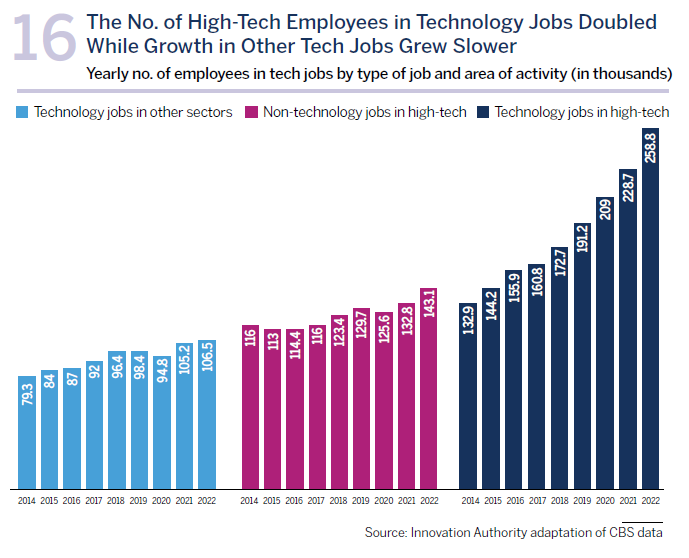
Furthermore, an analysis of the annual growth rate according to each of the job types and sectors shows that there was positive growth in the number of salaried employees in technology jobs in high-tech in each of the years examined (2014-2022). In contrast, the (non-technology) growth jobs in high-tech and the technology jobs in the general economy fluctuated and, in some of these years, even declined. For example, in the Covid pandemic year of 2020, there was a decline in the number of employees in these jobs. In other words, these jobs are more sensitive to market turbulence. Moreover, of the three job categories, the fastest growing category is that of technology jobs in high-tech which is growing faster than technology jobs in the rest of the economy and non-technology jobs in high-tech. In recent years (2019-2022), the growth rate of technology jobs in high-tech was four times higher than that of technology jobs in the economy at large, and 2.5 times higher than growth jobs in high-tech.
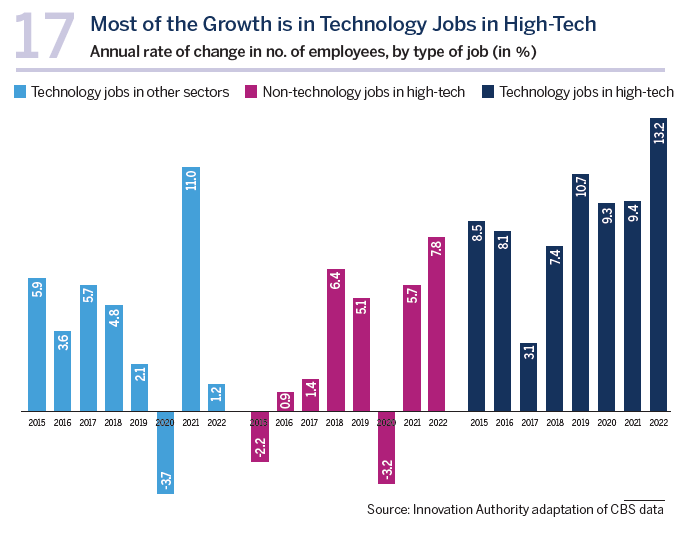
Women are still only a third of the industry, Arab and ultra-Orthodox societies only 5%
Another analysis we conducted relates to the employment trends of different sectors of the population in technology jobs in high-tech. The clear conclusion arising from the data is that despite the significant resources and efforts invested in diversification, and despite the accelerated growth of high-tech employment, a multi-year view shows that the disparities between the different population groups in high-tech. have been maintained. During a period of almost a decade, there were only minor fluctuations in the composition of the high-tech population. For example, women – the largest group underrepresented in high-tech – maintained their relative share of one third of the salaried employees in the high-tech sector and in technology jobs in the general economy. Throughout this period, the ratio of women remained almost unchanged, fluctuating between 32.8% and 34.2%. In 2022, this ratio was 33.4%. In other words, throughout this period, men continued to constitute two thirds of all high-tech employees.
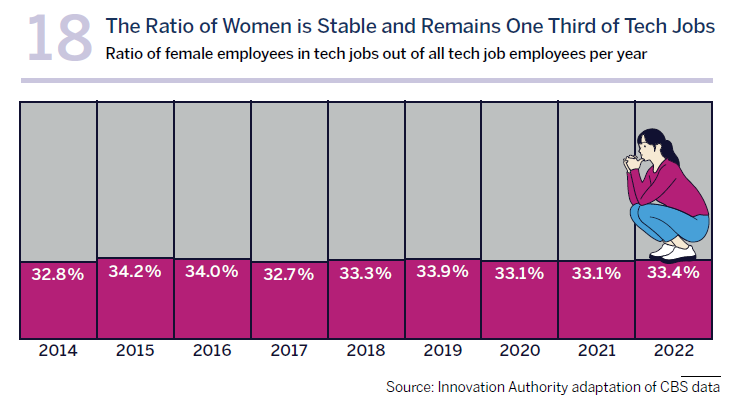
Progress in integrating Arabs and the ultra-Orthodox into high-tech is very slow. In 2014, 2% of the salaried employees in high-tech were from Arab society and 2.2% from ultra-Orthodox society. In 2022, the Arab sector’s representation in high-tech had risen by just 0.4% to 2.4%. In contrast, the ultra-Orthodox society is still underrepresented in high-tech but is growing at a quicker rate and its share of all salaried employees in high-tech and in technology jobs in the economy at large had increased to 3.2%. The growth was naturally led by ultra-Orthodox women who are joining high-tech at a rapid rate although their number is still relatively low and in 2022 totaled less than 11,500, after having tripled since 2014. In comparison, the number of non-ultra-Orthodox Jewish women was 149,000 in 2022. The number of ultra-Orthodox men in all jobs in high-tech was 5,000, and their growth rate since 2014 was about a quarter of that of ultra-Orthodox women.
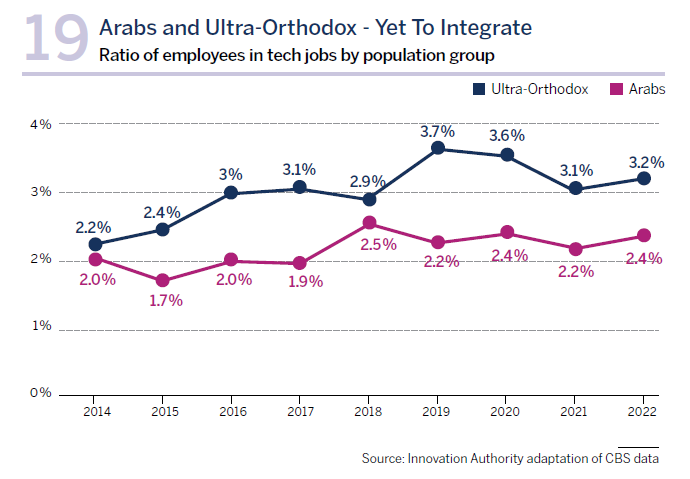
The final analysis relates to the different roles filled by high-tech personnel from the various groups. This analysis reveals disparities in the distribution of jobs between women and men and between different populations within the high-tech industry. As noted, the largest group in high-tech and in technology jobs is (non-ultra-Orthodox) Jews. The gender distribution of this group reveals a clear tendency of men to work more in technology jobs, compared to women who are the group with the largest representation among those working in jobs not at the core of technological activity. Among (non-ultra-Orthodox) Jewish men, 51% work in technology jobs in high-tech and another 20% work in technology jobs in other sectors. 29% of the men working as salaried employees in tech jobs work in non-technological jobs. In contrast, among (non-ultra-Orthodox) Jewish women approximately 40% work in technology jobs in high-tech and 19% work in technology jobs in other sectors. 41% of the women employed in tech jobs work in non-technology jobs.
In contrast, ultra-Orthodox and Arab women have extremely low representation in non-technology jobs. Only 4% of Arab women in high-tech are salaried employees working in non-technology jobs. The parallel figure for ultra-Orthodox women stands at 8%. In other words, in both these groups, there is a marked bias towards working in technology jobs.

